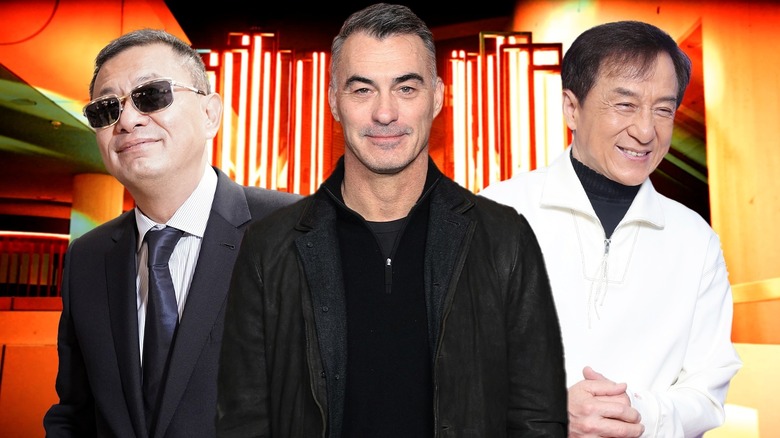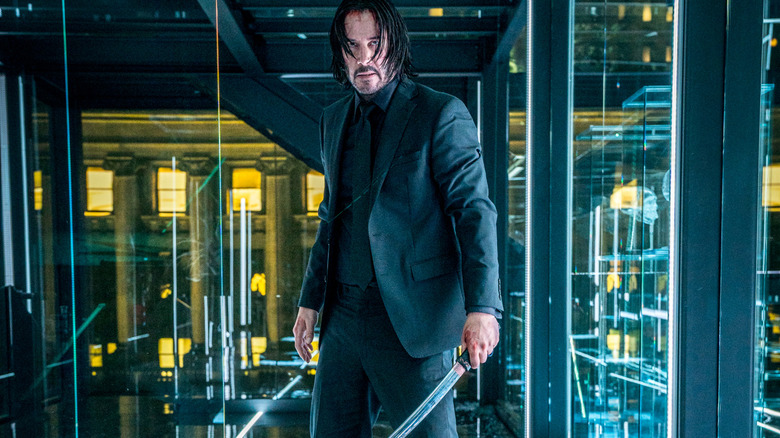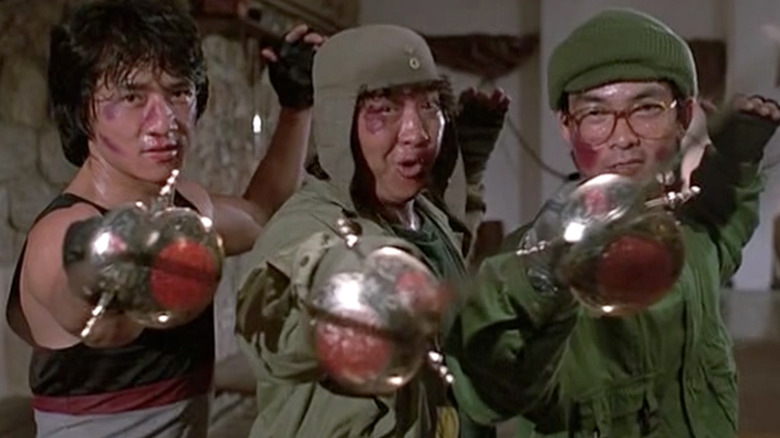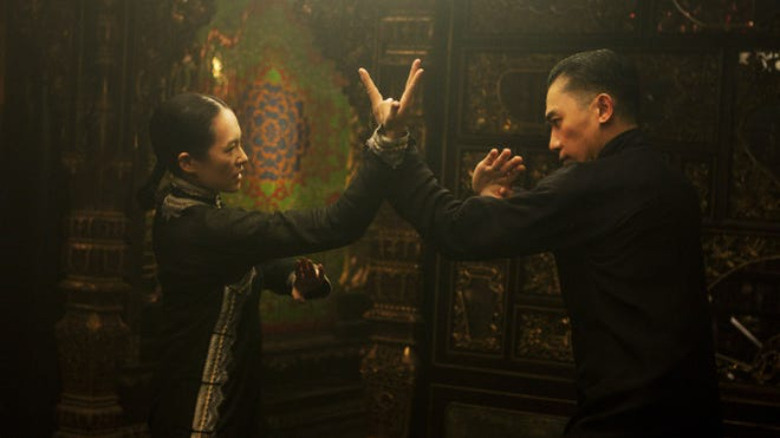From Jackie Chan To Wong Kar-Wai: Every Filmmaker And Actor Who Inspired John Wick: Chapter 4 Director Chad Stahelski [Exclusive]
When "John Wick" dropkicked its way into theaters in 2014, it raised the bar on U.S. action films but didn't quite feel like a total game changer at the time. Keanu Reeves as the sympathetic rogue assassin was undeniably cool and relatable without reaching instant icon status. The gun-fu interplay felt fresh and exciting with clear influences from Hong Kong cinema that most audiences were already at least somewhat familiar with. Director John Woo, for example, imported his unique blend of action and artistry with the shoot 'em up classics "The Killer" and "Hardboiled," introducing international audiences to a rebirth of cool in hitman movies that also had a soul.
Fast forward to "John Wick: Chapter 4." Reeves, director Chad Stahelski and the entire creative and technical teams have taken all of their influences from some of the greatest choreographers and martial artists to truly transcend the action genre. At nearly three hours long, the latest (and possibly final) entry is an exhaustive, exhilarating love letter to the masters that have come before while also firmly planting its own flag down to personally challenge the rest of the action world to try and top what they've achieved.
Reeves and Stahelski first met on "The Matrix" films, another franchise that was always quick to point out its martial arts influences and visual inspiration, from Shaw Brothers kung-fu sagas to Japanese anime like "Ghost in the Shell." So, it's no wonder that Stahelski has prided himself on paying respect to some of the best fight choreographers, performers, and legendary cinematographers that have inspired the "John Wick" team to reach new cinematic heights.
Akira Kurosawa, the samurai code, and the assassin's creed
In an interview with /Film, Chad Stahelski shares the names of some of the key artists that have helped shape the next level fights and grandiose locales that have come to define the increasingly rich landscape of the series:
"We learned from some of the best choreographers out there, both dance and martial arts, from Jackie Chan, Sammo Hung, Yuen Biao, Jet Lee, Yuen Woo-ping, Yuen Chen, Yuen Kuai — all these great Hong Kong choreographers or Chinese choreographers and Japanese choreographers from 'Zatoichi' and from Kurosawa's films."
The samurai code, otherwise known as Bushido, follows a very rigid ethical system that is meant to direct one's moral compass in an increasingly complicated world. There's no other director in history that has defined that way of life on celluloid more than Akira Kurosawa. Starring Toshirô Mifune, Kurosawa's "Seven Samurai" remains the high bar for sword-fighting epics called Chambara films that use the samurai code to establish some sense of order and justice for those who never receive it.
One crucial designation that makes the world of "John Wick" stand out among the myriad of action blockbusters is its world building and gradual additions to its ever-expanding mythology. Although John Wick is truly an army of one, the influence of "Seven Samurai" on "John Wick" is readily apparent through the assassin's creed that Wick and the other killers follow. The rules of the Continental Hotel and the old ways of the High Table are simple but unbreakable. Much like the code of the samurai, the rules of "John Wick" are easily understood but to truly walk the honorable path is almost impossible.
Stahelski has also referenced the great Takashi Miike's "Hara-Kiri" and admitted his obsession with all 26 episodes of "Zatoichi." Granted, the "John Wick" series would probably still exist if Kurosawa had never made "Seven Samurai," but Wick's nobility comes from having the heart and allegiance of a samurai.
The three brothers of Hong Kong cinema
There are two constants in this venerable action franchise: John Wick must face impossible odds alone and, when all hope seems lost, a helping hand is always offered when it's most needed. Whether it's Winston (Ian McShane) remaining in Wick's corner when he becomes persona non grata or the Bowery King (Laurence Fishburne) allowing him passage into the mole city underneath Manhattan, Wick always has a friend. Wick has never betrayed anyone and has always acted above board (except for that one time he shot Santino in the Continental). His loyalty is a rare commodity and it serves him well.
No other trio in martial arts history represents friendship and loyalty more than Jackie Chan, Yuen Biao, and Sammo Hung. All three were subjected to near torturous levels of training at the China Drama Academy where they learned acrobatics and theatricality together. Their partnership has led to some of the greatest martial arts acting comedies of all time, including "Wheels on Meals," "Project A," and "Eastern Condors." I grew up watching their jaw-dropping athleticism set against some truly staggering set pieces and backdrops. Their films added a new level of action that never undermined how affable each actor, especially Sammo, was on screen.
Chad Stahelski name dropping all three actors back-to-back makes their influence clear on the "John Wick" franchise as a whole. More so than any other entry, "John Wick: Chapter 4" plays with the balance between comedy and action that this trio — known as the three brothers — made famous. In this fourth entry, audiences may be surprised at some unexpected team ups and the larger-than-life character Killa (Scott Adkins) that Wick faces could easily have been inspired by the improbable balletic moves and elastic kicks of Sammo Hung.
The coolest director and the legendary fight choreographer
The great martial artists and stunt men in "John Wick: Chapter 4" — including the aforementioned Scott Adkins, Marko Zaror from "Kiltro" and "Mandrill" fame, the legendary Hiroyuki Sanada, and the incomparable Donnie Yen — are all going to receive a great deal of acclaim for their incredible performances. Chad Stahelski and cinematographer Dan Laustsen also deserve a lot of credit for taking inspiration from some of the titans of filmmaking to create gorgeous set pieces that deliver a stunning level of grandeur and beauty.
"I'm a huge Wong Kar-wai or a Zhang Yimou fan, so 'The Grandmaster' or 'In the Mood for Love,'" Stahelski tells /FIlm. "You take Roger Deakins or Bob Richardson, the great cinematographers from our world, and what color can mean emotionally, and you play with that." Mentioning visionary director Wong Kar-wai's first foray into the world of martial arts with the Ip Man origin story "The Grandmaster" makes perfect sense as a key influence on the world of "John Wick." "The Grandmaster" combines Wong Kar-wai's hypnotic use of color with the unparalleled action choreography of Yuen Woo-ping to elevate a relatively straightforward story about the man who would go on to train Bruce Lee.
Roger Deakins ("Empire of Light") and Bob Richardson ("Once Upon A Time in Hollywood") are certainly inspirations for Laustsen, but acknowledging "In the Mood for Love" specifically should also shine a light on the work done by cinematographer Christopher Doyle. Interestingly, the character of John Wick is a loving husband first and foremost, and "In the Mood for Love" is considered one of the greatest romances of all time. For "The Grandmaster," Wong Kar-wai employed his artistry to action; with "John Wick: Chapter 4," Stahelski took inspiration from the most unlikeliest of places to transform action into art.
The action film as a true art form
Director Zhang Yimou and Jet Li have both been listed as lasting influences on the "John Wick" series. Their soaring war epic "Hero" certainly stands alongside "Seven Samurai" and "The Grandmaster" in the pantheon of great martial arts masterpieces. It is a staggering work of art that just happens to have some of the greatest battles ever seen on film. "Hero" sets a high bar that, up to this point, no U.S. action film has dared to aspire to. For all the hyperbole, "John Wick: Chapter 4" displays a truly awesome combination of inventive, crowd-pleasing fight scenes with a level of pathos and virtuosity that should go unmatched for a long while. The one man army of Jet Li's character Nameless and Keanu Reeves' phantom killer Baba Yaga share quite a bit in common.
Chad Stahelski and the entire production team aren't having delusions of grandeur, necessarily, in their attempts to make something truly special. "We know we're making this goofy, modern day fantasy action movie that combines samurai, wuxia, dogs, cars, guns, whatever, but we still see ourselves as artsy filmmakers," he says. "I consider myself very much a craftsman, and my crew are craftsmen, with the dream of becoming an artist. We're very good at what we do technically, but it's the translation of what we do into that next level that becomes artistry."
Having the chance to create four movies over the last decade has given Keanu Reeves and the multitude of stunt performers and technicians a chance to move beyond the sheer spectacle of stylized action. It's allowed them to cull together all of the films and filmmakers they love to create something that should resonate at a much deeper level than any film with this many shots to the head ever should.
"John Wick: Chapter 4" premieres in theaters on March 24, 2023.




